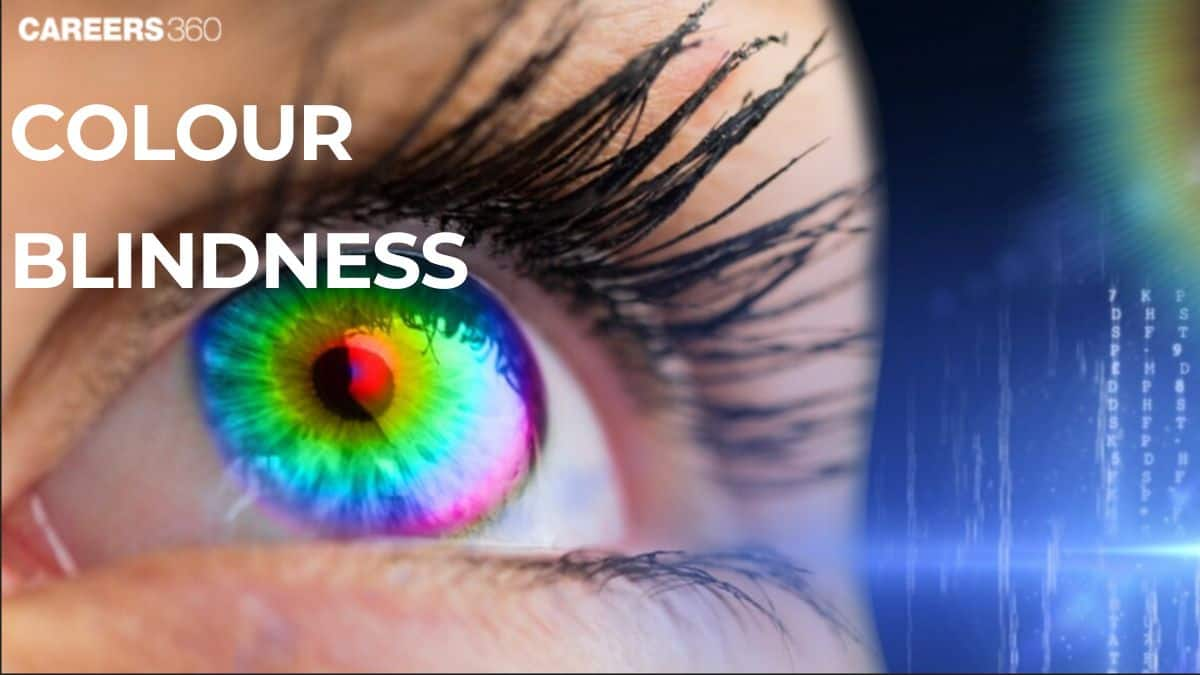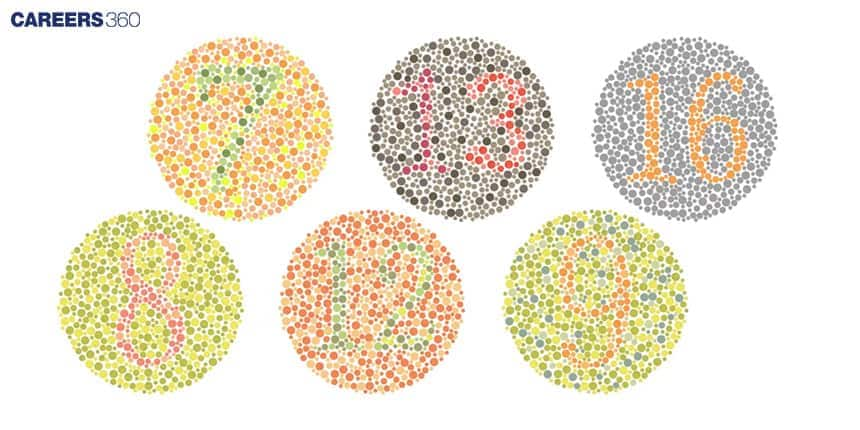Color Blindness: Types, Causes, Treatment, Genetics, Diagnosis, Symptoms
Colour blindness is one’s decreased ability to judge differences between colours. The severity of colour blindness varies from mostly unnoticeable to full absence to judge the difference. It is a sex-linked inherited disease, or variation in the function of one or more of the three classes of cone cells of the retina, which help in colour vision.
This Story also Contains
- What Is Colour Blindness?
- Types of Colour Blindness
- Causes of Colour Blindness
- Symptoms of Colour Blindness
- Diagnosis of Colour Blindness
- Treatment of Colour Blindness
- Coping and Support Mechanism
- Recommended Video on Colour Blindness:
- MCQs on Colour Blindness:

The most common form is the genetic condition called the congenital red-green colour blindness. This affects up to 1 in 12 males and 1 in 200 females. The condition is more commonly seen in males as the opsin gene is located on the X chromosome. The disease can also result from physical or chemical damage to the eye, the optic nerve, parts of the brain, or from medication toxicity. Colour blindness is a topic of the chapter Principles of Inheritance and Variation in Biology.
What Is Colour Blindness?
Colour blindness refers to a person's inability to see colours in the usual way, and the disorder is located in one or more of the light-sensitive cells of the retina of the structure of human eye, which detect colours. The most common forms of colour blindness involve problems with distinguishing red from green. Another form involves an inability to see blue from yellow. Other X-linked diseases include haemophilia, fragile X syndrome, etc.
Colour blindness awareness is important because a large proportion comes in varying degrees. It poses an impact on daily life, education, and even offers viable options for careers. Awareness of the facts concerning the condition can help. Hence, creating an understanding of the appropriate coping strategies and seeking support is important.
Types of Colour Blindness
Colour blindness can be categorised based on the number of functional colour receptors present in the eye. There are two main types: monochromacy and dichromacy.
Monochromacy: Also referred to as total colour blindness, it is caused by two or all three of the cone types being non-functional. A person suffering from this disorder will not be able to perceive any colour at all and will see the world in shades of grey.
Dichromacy: A state in which only two of the three cone types are functioning. This can be further divided into:
Protanopia: Absence of red cones
Deuteranopia: Absence of green cones
Tritanopia: Absence of blue cones
Causes of Colour Blindness
Colour blindness is mostly a genetic disorder, passed down from one's parents. The genes responsible for the very common types of colour blindness reside on the X chromosome. Therefore, the disease is a result of chromosomal abnormality. This explains the more common prevalence of colour blindness among males.
Genetic Mutations: Colour blindness results from specific types of mutations in the opsin genes, which code for light-sensitive proteins in cones.
X-linked Inheritance: Since the male possesses a single X chromosome, a single defective gene can lead to Colour Blindness, whereas in females with two X chromosomes both copies of the gene have to be defective.
Other Causes:
Certain medications
Eye diseases
Ageing
Other causes that could create colour blindness include retina, optic nerve, or brain damage—especially those involved in processing colour information.
Symptoms of Colour Blindness
Symptoms usually manifest in the form of difficulty differentiating between colours. Various symptoms of colour blindness include:
Difficulty in differentiating between shades of red and green
Difficulty distinguishing different shades of blue and yellow
Inability to see any colour at all (in very rare cases)
Difficulty in running everyday errands that involve the identification of colours, such as reading coloured charts or maps
Difficulty distinguishing between ripe fruits or telling traffic light colours
Diagnosis of Colour Blindness
These tests are normally administered for diagnosing colour blindness, which defines the degree and kind of defects in colour vision.
Ishihara Test: The test is based on a series of plates with dots in different colours and sizes. Within these dots, numbers or shapes are embedded that would only appear to the subject of examination with normal colour vision. This test is especially good for diagnosing red-green colour blindness.
Below is the Ishihara chart for the diagnosis of colour blindness:

Screening Test: Other tests use the same principle of arrangement of pieces of coloured tiles in a similar hue order, such as the Farnsworth-Munsell 100 Hue Test. These tests are used for classifying specific types and degrees of colour vision deficiencies.
Treatment of Colour Blindness
Currently, colour blindness is an incurable condition, but different treatments and coping mechanisms have been developed to overcome this deficiency.
Current Treatments
Special Lenses and Glasses: Particularly designed to enhance colour differentiation, some lenses, such as EnChroma glasses, filter out specific wavelengths of light that allow blind colour people to distinguish better.
Gene Therapy (Under Development Treatments): Research is going on in gene therapy as a possible treatment. This treatment aims to correct faulty genes responsible for colour blindness.
Coping and Support Mechanism
Many organisations provide resources and support groups for the colour-blind. Support groups are a forum for important sharing and strategising. Awareness about colour blindness in schools and the workplace can bring about accommodation and understanding. High-contrast visuals and avoidance of reliance on colour alone carrying information make all the difference.
Recommended Video on Colour Blindness:
MCQs on Colour Blindness:
Q1. Red-green color blindness in a person is
Option 1: Sex-linked character
Option 2: Criss-cross inheritance
Option 3: Both (a) and (b)
Option 4: (a), (b), and (c)
Correct answer: 4) (a), (b), and (c)
Explanation:
Red-green color vision deficiency is a prevalent form of color blindness, characterized by difficulty distinguishing between red and green hues. This condition is primarily genetic in origin, resulting from a mutation on the X chromosome that impacts retinal cone cells. These photoreceptors are crucial for detecting light wavelengths corresponding to red and green.
The causative factor typically involves a genetic alteration affecting X-linked chromosomes, leading to impaired function in the cones. Since males possess a single X chromosome (XY), they exhibit color blindness more frequently than females, who have two X chromosomes (XX). Female color blindness occurs only if both X chromosomes harbor the defective gene.
Hence, the correct answer is option 4) (a), (b), and (c)
Q2. Suppose a man is colorblind. What are the chances of his son inheriting color blindness from him?
Option 1: 0
Option 2: 50%
Option 3: 100%
Option 4: None of the above
Correct answer: (1) 0.
Explanation:
This colour blindness is sex-linked, where the disorder's primary causation is the location of genes responsible for it, mainly on the X chromosome. A male carries one X inherited from his mother and therefore has to carry one defective recessive gene for color blindness. A male cannot pass an X chromosome from his body, as his male child receives only his father's Y chromosome. Hence there is a 0% possibility for a son getting color blindness through his father.
Hence, the correct answer is Option (1) 0.
Q3. What percentage of male children born to this couple who have a colour-blind father and a normal mother will also be colour-blind? For example, a man with a colour-blind father marries a woman with a colour-blind mother and a normal father.
Option 1: 50%
Option 2: 75%
Option 3: 25%
Option 4: 0
Correct answer: 1) 50%
Explanation:
This is an X chromosome-linked autosomal recessive disorder that affects sons and daughters in a progeny-by-progeny fashion. The son is inherited through his mother, while the daughter is inherited through his father.
There is a possibility that a woman can become colourblind if she is homozygous for the recessive gene that causes colour blindness.
From the X chromosome she received from her mother, the woman carries a gene that makes her colour-blind. Despite this, her other X chromosome is normal since her father is a normal visionary.
The recessive colourblind gene will be present in 50% of the eggs while the dominant gene will be present in 50% of the eggs.
In spite of the fact that his father was colourblind, the man is normal due to the fact that his X chromosome came from his mother. This means that all of the sperm with an X chromosome will carry the normal dominant gene for colour blindness.
Consequently, 50% of the eggs with the recessive colourblind gene will produce either females with the recessive colourblind gene or males with the recessive colourblind gene. There will therefore be 50% of male progeny who are colorblind among all the male offspring.
Option (2) is an incorrect answer
Due to the fact that half of all eggs will contain a gene for colour blindness, 75% of male children will be affected by this condition.
Option (3) is an incorrect answer
There is a 50% chance that all children have a gene that causes them to be colourblind. Some of them will become female and some will become male. Thus, there is a possibility that 50% of the offspring will be male and colourblind.
Option (4) is an incorrect answer
Since colour blindness is an X-chromosome-linked disease which is passed from mother to son, the mother mentioned here is a carrier of the disease and 50% of her sons will develop the disease as well.
Hence, the correct answer is option 1) 50%
Also Read:
Frequently Asked Questions (FAQs)
Colour blindness can be checked on Digital web-based tools and apps that offer tests like the Ishihara Test, which includes the identification of numbers within coloured dot patterns.
Colour blindness refers to a defect in an individual whereby a person cannot view certain colours correctly. Normally, it is passed genetically by the mutations of the X-chromosome genes, hence found more in males in most cases.
No successful cure for colour blindness has been made yet, but treatments include special lenses and glasses that help deal with the condition. Gene therapy is a potential emerging treatment.
Colour-blind people develop coping mechanisms by working on patterns and shapes instead of colours, along with labels of text rather than relying on colours. They also make use of today's technology like mobile phone apps and special glasses that help them discriminate on colours.
Those careers that unilaterally require acute colour perception, such as pilots, electricians, and graphic designers, may be closed to colour-blind individuals.